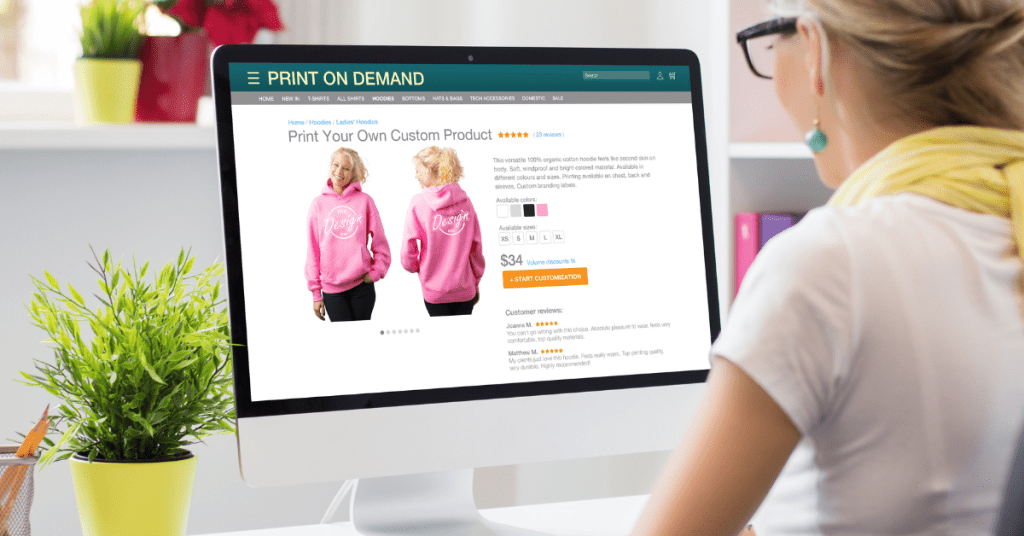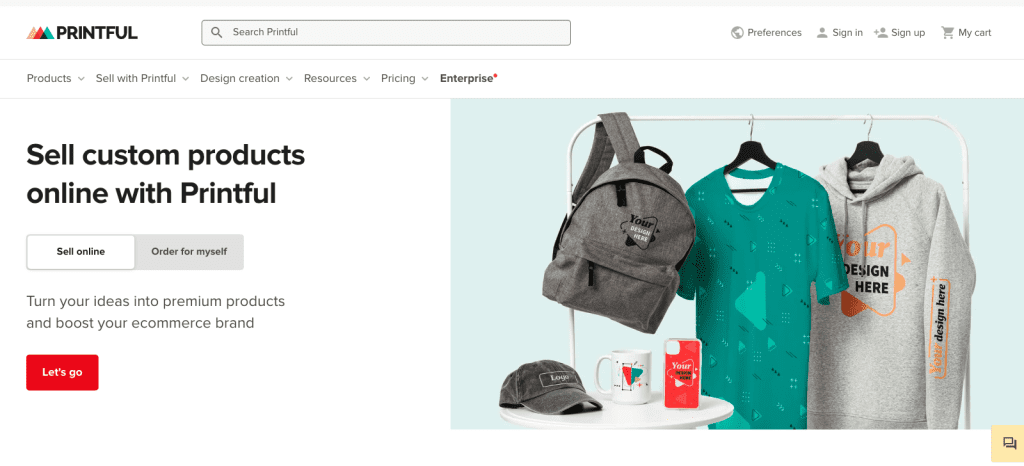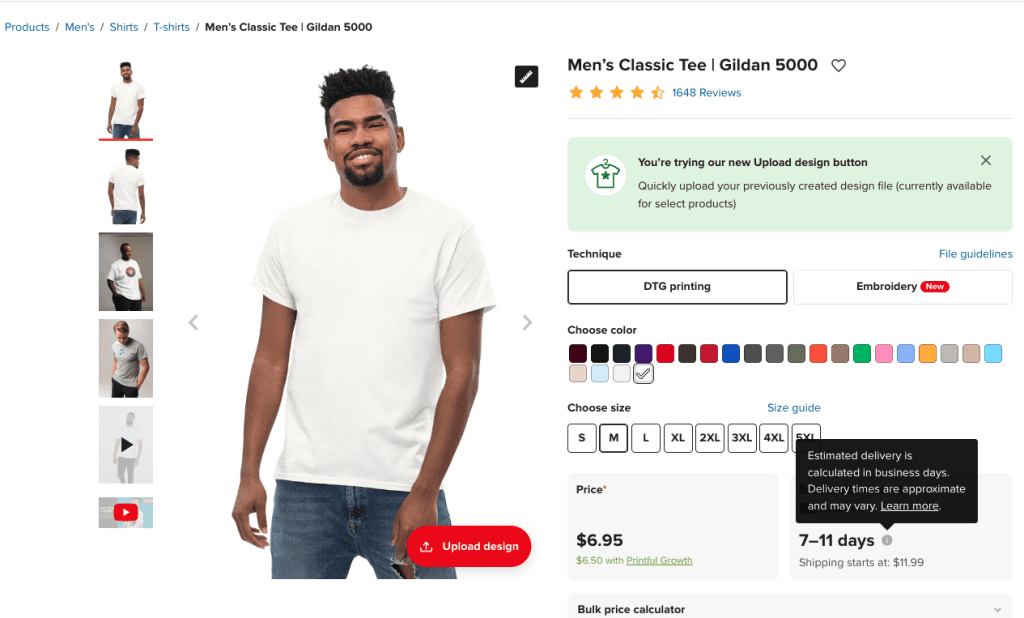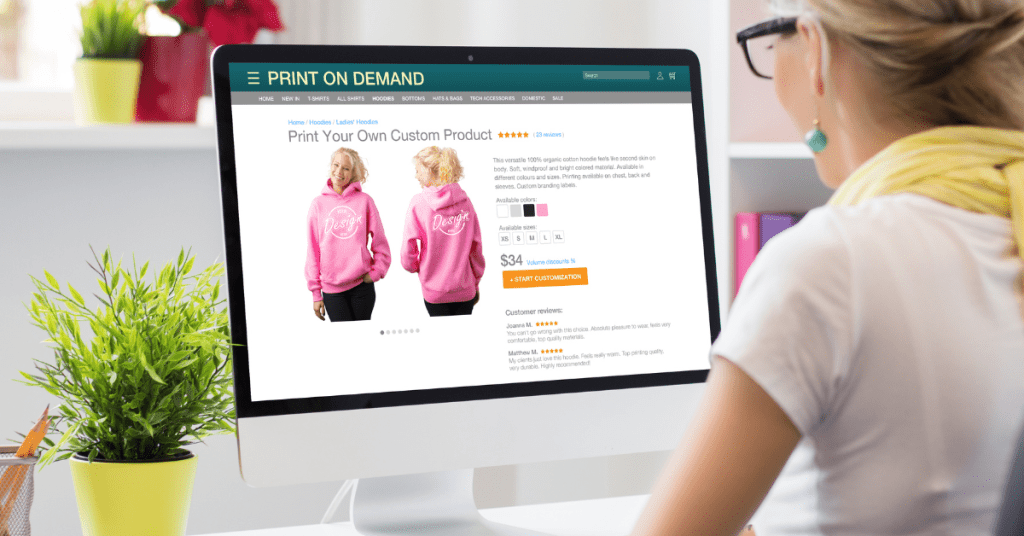Embarking on the journey of a clothing business might initially seem daunting. The prospect of mastering sewing machines, organizing space for a growing product collection, and efficiently handling order dispatches, all while juggling other life and work commitments, can be overwhelming. However, what if there was a way to sidestep these traditional challenges?
This blog post aims to unravel the transformative potential of platforms like Printful in revolutionizing your approach to the clothing business. By leveraging such platforms, you can make the entire process more manageable, scalable, and, most importantly, enjoyable.
We’ll walk you through the essential steps of starting a small clothing business from home. Whether you’re a budding designer, a fashion enthusiast, or someone eager to turn passion into profit, consider this post your starter pack to transform your dreams into reality. Prepare to embark on a path that seamlessly merges creativity with commerce, all within the confines of your haven. Let’s dive in and get started!
1. Find your niche – Start a Small Clothing Business
Starting your venture into the clothing industry, the initial and important step involves defining a niche. It goes beyond merely selecting products. Instead, it entails pinpointing a market space that aligns with your style and the preferences of your intended audience. A niche establishes the character of your brand, enabling you to distinguish yourself in the dynamic fashion landscape.
What’s A Niche?
So, what exactly is a niche? In ecommerce, particularly in the print-on-demand (POD) and dropshipping sector, a niche is indispensable. It also enables businesses to target a specific customer segment with distinct preferences and requirements. Essentially, a niche will then denote a specialized market segment for a particular product or service.

By recognizing and catering to a niche, you can then concentrate your efforts on a clearly defined audience, enhancing the effectiveness of your marketing strategies and making your products more attractive. This approach minimizes competition while focusing on appealing to a select group seeking specific clothing styles. Besides, proficiently addressing a niche can foster loyalty, elevate brand recognition, and sustain business growth over time.
In the clothing business, a niche can encompass anything with a unique style and/or a target market that you aim to primarily serve. For instance, an ecommerce store specific to a niche might feature classic dad puns on their t-shirts that resonate with fathers or humorous animal memes infused with a younger group.
Alternatively, a niche could also revolve around a collection centred on sustainable, eco-friendly fabrics, appealing to environmentally conscious consumers. It might also manifest as a line paying homage to vintage styles, targeting individuals with an affinity for retro fashion. The possibilities are nearly limitless.
The crucial aspect is that your chosen niche should also align with your interests and cater to the specific needs or desires of your target market. The key is to identify a market gap that passionately drives you. This not only establishes a distinctive identity for your brand but also fosters a profound connection with your customers.
How To Pick A Niche?
Before selecting a niche, it’s essential to consider the strategic aspects of your approach. Here are some key steps to ensure that your choice is not unique but also holds the potential for success.
Evaluate Market Demand:
- Opt for a niche that is both intriguing and promises sustainable growth. This can cater to a customer base that will continue to appreciate your products in the years to come.
Examine Competition:
- Analyze the competitive landscape within your desired niche.
- Be mindful of healthy competition, but exercise caution in areas saturated with well-established players unless you bring a fresh perspective.
- Identify direct competitors offering similar products.
- Inspect the quality, pricing, design styles, and variety of products offered by competitors to understand customer preferences.
- Review competitors’ websites and social media channels, focusing on branding, communication tone, customer engagement, and online reviews.
- Observe their marketing strategies, including advertising channels, content marketing, SEO, and social media campaigns.
- Conduct a SWOT analysis for each key competitor to identify strengths, weaknesses, opportunities, and threats.
- Determine how competitors position themselves in the market (budget option, luxury brand, or in-between) to find your unique positioning.
- Engage in relevant forums, social media groups, and community platforms to understand the needs and sentiments of your niche.
Passion and Long-term Commitment:
- Ensure you have genuine passion and expertise in the chosen niche, as you’ll be working in it for an extended period.
- Your enthusiasm and knowledge will contribute significantly to creating an authentic connection with your audience.
Identify Target Audience:
- Ensure your chosen niche resonates with your ideal customer’s tastes, preferences, lifestyle, and values.
- Establish a genuine connection with your target audience through your niche.
Market Testing:
- Before fully committing, test the market by launching a limited product range or a preliminary version of your store.
- Gather customer feedback and assess market interest to make informed decisions.
Understanding the core values and preferences of your niche audience is crucial. If your niche is aligned with trend-driven markets like streetwear or fast fashion, staying updated with trends is imperative.
2. Choose A Fulfilment Option – Start a Small Clothing Business
Handmade
Choosing handmade items for your business demonstrates a commitment to the art of personalization and superior craftsmanship. Ideal for brands specializing in unique, artisanal creations, the handmade approach strongly resonates with customers who appreciate owning something exclusive and meticulously crafted.
The customization possibilities inherent in handmade products allow for tailoring to specific customer preferences, fostering a profound connection between the product and its owner. This strategy often attracts a devoted customer base that values the human touch evident in every stitch and cut.
While adopting this approach demands a significant investment in time and resources, it presents an unparalleled opportunity to establish a brand synonymous with quality and exclusivity. Handmade products typically carry a higher perceived value, enabling premium pricing. Additionally, they open avenues to niche markets seeking authenticity and storytelling embedded in handcrafted apparel.
Importantly, embracing handmade products does not necessarily constrain your capacity to scale. With careful planning and a focus on efficient production techniques, expanding your business while upholding high standards of handmade quality is possible. Strategies such as limited edition releases or made-to-order models can effectively manage demand while preserving the exclusivity of your offerings.
Print-on-demand (POD)
Print-on-demand (POD) emerges as a contemporary solution seamlessly fitting into an efficient and agile business model. This option proves ideal for those seeking design flexibility and minimal upfront costs.

In the print-on-demand framework, products come to life only upon receiving an order, mitigating the risk of excess inventory. It grants the freedom to experiment with diverse designs and products without incurring significant financial commitments.
Platforms like Printful simplify the integration of print-on-demand into your online store, offering an extensive array of products spanning apparel, accessories, and more. Opting for a POD model, such as Printful, brings forth numerous advantages:
- No initial investment required
- Access to the entire product catalogue for customization
- Elimination of the need to maintain inventory
- Automated product fulfilment
- Global shipping capabilities
- Opportunities for experimentation with product designs
- Professional mockup generator for your product photos
- Round-the-clock support from a dedicated customer service team
When deciding between handmade and print-on-demand, considerations should revolve around your brand narrative, product nature, customer expectations, and your production and fulfilment capabilities. Each option carries its distinct benefits, and the optimal choice depends on what aligns best with your business vision and operational capacities.
3. Get samples – Start a Small Clothing Business
Before fully committing to either a handmade or Print-On-Demand (POD) business model, obtaining samples emerges as a crucial step. Samples serve as a means for you to personally assess the quality, feel, and overall appeal of your products, ensuring they meet your standards and resonate with your target audience.
For Handmade Products:
Craft Initial Prototypes:
- If you’re personally creating the products, develop a few prototypes to refine the design, materials, and production process.
Partner with Artisans:
- If collaborating with artisans or small workshops, request sample products to assess their craftsmanship and consistency.
Evaluate Material Quality:
- Pay close attention to the materials used, ensuring they align with your brand’s quality standards and appeal to your customer base.
Test for Durability:
- Durability is crucial, particularly for handmade items. You need to conduct tests on the samples to ensure they can withstand regular use.
Consider Customer Experience:
- Contemplate the unboxing experience and how the product feels in the hands of the customer. Recognize the significance of first impressions.
This meticulous sampling process allows you to fine-tune your products before launching, contributing to the success and satisfaction of your business.
For Print-on-demand Products:
Ordering a sample of your designed product provides valuable insight into the customer’s perspective regarding the ordering process, delivery, packaging, and product quality.
Firstly, conduct a thorough assessment of print or embroidery quality, checking for colour accuracy and detailing to ensure they align with the standards your brand represents. Then, evaluate the diverse product range offered by Print-On-Demand (POD) by ordering different items to gauge their quality and how your designs translate across various mediums.
For apparel, it is essential to test the wash and wear durability of the products to ensure longevity and customer satisfaction. Adhere to the care instructions provided before conducting these tests.
You may create a feedback loop by using sample products to gather input from friends and family. Then, utilize this feedback to make adjustments to your designs or identify products with potential for better sales.
By obtaining and meticulously evaluating samples, you can then make informed decisions about which fulfilment option best suits your business. This process also aids in fine-tuning your product offerings to ensure they not only align with your vision but also delight your customers. The quality of your products will directly reflect your brand, and ensuring excellence from the start establishes the foundation for a successful business.
Start Your Print-on-demand Business Today
4. Develop your brand identity – Start a Small Clothing Business
Establishing a compelling brand identity is a critical step for business owners, especially in the competitive Print-On-Demand (POD) landscape. Beyond mere logos or colour schemes, your brand identity encapsulates your business’s personality, values, and promises made to customers.
In this guide, we’ll explore how to develop a brand identity that stands out and resonates deeply with your target audience.
Choosing A Brand Name
Firstly, when choosing a brand name, immerse yourself in a brainstorming session to discover a name that truly reflects your brand’s essence. You can also experiment with different combinations, consider using a name generator for inspiration, and seek feedback on shortlisted names to choose the one that aligns best with your brand’s vision.

Secondly, defining your brand’s heart is essential. Understand what your brand stands for, including core values and mission. This understanding will then form the foundational elements of your brand identity. In addition, identify your Unique Selling Proposition (USP) to determine what makes your store unique, be it your design style, product quality, or commitment to customer service. Your USP becomes a key element in setting your brand apart in the market.
Defining Your Mission and Vision Statements
Moving on, crafting mission and vision statements is crucial. A concise mission statement should define your brand’s purpose and core values, while a vision statement articulates long-term aspirations, reflecting your brand’s overarching goals and values.
Narrating your brand story
Then, narrating your brand story becomes a powerful tool for building connections. You can share the journey that led to your brand, the values that drive it, and the aspirations you hold. This narrative helps build trust and rapport with your audience, particularly important for new businesses striving to establish credibility. You may use your story to craft an engaging ‘About Us’ page on your website, ensuring the tone and language mirror your brand’s personality.
Visual identity
Lastly, the visual identity of your brand, encompassing elements such as logos, colour palette, typography, and overall design aesthetics, forms the visual language that communicates your brand’s personality. Consistency across all platforms, from your website to social media, is key for building brand recognition and conveying professionalism.
Besides, you need to ensure that every visual aspect resonates with your brand’s character and speaks directly to your target audience. By carefully crafting these elements, you can build a brand identity that not only distinguishes your business but also fosters a meaningful connection with your audience.
5. Create an online store – Start a Small Clothing Business
Embarking on the journey of launching an online store holds immense significance when establishing your small clothing business. Essentially, your online store functions as a digital storefront, serving as the primary avenue for customers to engage with and explore your brand and its array of products. It also acts as the virtual gateway through which potential buyers connect with the essence of your clothing line.
In this section, we will not only explore the important role of an online store but also the intricacies of creating one. Besides, we will also be showing how to integrate with your POD supplier.
From the initial setup to the finer details of customization, we’ll then navigate the process together, ensuring your online store becomes a compelling platform for showcasing your brand and connecting with your target audience.
Step 1: Choose the right ecommerce platform – Start a Small Clothing Business
Choosing the right ecommerce platform is a crucial decision that significantly influences the success of your online store. Each platform comes with its own features, strengths, and considerations. For example:
Shopify:
- Ease of Use: Shopify is renowned for its user-friendly interface. It offers a straightforward setup process, making it an ideal choice for beginners.
- Design and Customization: The platform provides a range of customizable templates, allowing you to create a visually appealing and unique storefront without extensive coding knowledge.
- Payment Integration: Shopify offers seamless integration with various payment gateways, streamlining the checkout process for customers.
- Scalability: It caters to businesses of all sizes, ensuring scalability as your clothing business grows.

WooCommerce (WordPress):
- Flexibility: WooCommerce is a plugin for WordPress. It provides flexibility for those already using WordPress for their website. It allows extensive customization and control over your online store.
- Cost-Effectiveness: WooCommerce is an open-source plugin, making it cost-effective. However, you’ll need to consider additional expenses like hosting and domain registration.
- Content Management: If content marketing is a significant part of your strategy, the integration with WordPress allows you to seamlessly incorporate a blog into your ecommerce site.
- Community Support: Being part of the WordPress ecosystem, WooCommerce benefits from a vast community, offering support and a wide range of plugins for added functionality.

Etsy:
- Built-In Marketplace: Etsy is a marketplace platform where your products become part of a larger community. This can expose your clothing business to a built-in audience.
- Brand Exposure: The platform has a well-established reputation, providing your brand with immediate exposure to a diverse range of shoppers looking for unique and handmade items.
- Ease of Use: Etsy simplifies the selling process, making it suitable for those who prefer a more straightforward setup without needing a standalone website.
- Fees: While Etsy charges fees for listings and transactions, the built-in audience and marketing exposure can compensate for these costs.

When choosing an ecommerce platform, consider factors such as your technical expertise, budget, customization needs, and the specific features offered by each platform. It’s often beneficial to weigh the pros and cons based on your business goals, target audience, and long-term vision for your clothing business.
Step 2: Create a Printful Account – Start a Small Clothing Business
Creating a Printful account is a straightforward process that allows you to seamlessly integrate print-on-demand services into your online store. To start, you need to visit the Printful Website. Then, locate the “Sign Up” or “Get Started” button on the homepage and click on it.

Follow the steps to fill in all the required information to create your Printful Account.
Start Your Print-on-demand Business Today
Step 3: Connect your store with Printful – Start a Small Clothing Business
After completing your profile, you will be prompted to connect to your online store platform. Printful integrates with various ecommerce platforms such as Shopify, WooCommerce, Etsy, and more. Choose your platform and follow the on-screen instructions to connect your store.

To use Printful’s services, you need to set up billing information. Enter your credit card details or connect your PayPal account for seamless transactions.
Step 4: Create Your First Product – Start a Small Clothing Business
Once your account is set up, you’ll have access to the Printful dashboard. Here, you can explore product catalogues, upload your designs, and manage your orders.

Once you have your product selected, you can navigate to the “Mockup Generator” or similar section on Printful. Then, upload your designs onto the products to see how they will look. This step is crucial for visualizing your merchandise and preparing for the actual printing process.
Once you have your product selected, customize your settings, to include pricing, shipping preferences, and any additional branding elements.
Start Your Print-on-demand Business Today
6. Promote Your Clothing Business – Start a Small Clothing Business
Promoting your clothing business effectively is crucial for attracting customers and building a strong brand presence. Here are detailed ways to promote your clothing business:
Online Presence:
- Social Media Marketing: Leverage social media platforms like Instagram, Facebook, Pinterest, and Twitter to create a strong online presence. Share high-quality images, engage with your audience, and use relevant hashtags to increase visibility.
- Blogging: Start a blog on your website to share fashion tips, style guides, and industry trends. This can enhance your brand’s credibility and attract organic traffic.
Content Marketing:
- Visual Content: Invest in professional photography to showcase your clothing items. High-quality visuals can significantly impact customer perception.
- Video Marketing: Create engaging videos, such as behind-the-scenes looks, styling tutorials, or customer testimonials. Videos can be shared on social media, your website, or YouTube.
Influencer Collaborations:
- Partner with influencers in the fashion industry to showcase your products. Influencers can reach a broader audience and provide authentic endorsements, increasing brand credibility.
Email Marketing:
- Build an email subscriber list and send regular newsletters. Include information about new arrivals, promotions, and exclusive offers. Personalize your emails to make customers feel valued.
Search Engine Optimization (SEO):
- Optimize your website for search engines to improve its visibility. Use relevant keywords in product descriptions, blog posts, and meta tags to enhance your search engine ranking.
Collaborations and Partnerships:
- Collaborate with other businesses, fashion bloggers, or local influencers for joint promotions. This can help you tap into new audiences and create a buzz around your brand.
Customer Loyalty Programs:
- Implement a customer loyalty program to encourage repeat purchases. Offer discounts, exclusive previews, or loyalty points for every purchase, fostering a strong connection with your customers.
Online Advertising:
- Use paid advertising on platforms like Google Ads or social media to target specific demographics. Running targeted ads can increase visibility among potential customers.
Referral Programs:
- Encourage existing customers to refer friends by implementing a referral program. Offer incentives, such as discounts or exclusive products, for successful referrals.
Packaging and Unboxing Experience:
- Design unique and aesthetically pleasing packaging to enhance the unboxing experience. Encourage customers to share their unboxing moments on social media, creating an organic promotion.
By incorporating these strategies, you can create a comprehensive and effective promotional plan for your clothing business, reaching a wider audience and building a loyal customer base.
Final Thoughts: How to Start a Small Clothing Business From Home in 6 Simple Steps
Embarking on the journey of starting a small clothing business from the comfort of your home is an exciting endeavour. By following these six simple steps, you’ve laid the foundation for turning your passion into a thriving venture. Since the world of entrepreneurship is ever-evolving, each step you take contributes to the unique narrative of your business.
The path of an entrepreneur is filled with vibrancy and dynamism. Celebrate the milestones, learn from challenges, and always keep your passion for fashion at the core of your business. Stay stylish, stay inspired, and relish every moment of this exciting adventure.
The runway is ready, and it’s your time to take off! As you navigate the ever-evolving landscape of the fashion business, remember that success comes not only from the products you create but also from the unique story you weave through your brand.





